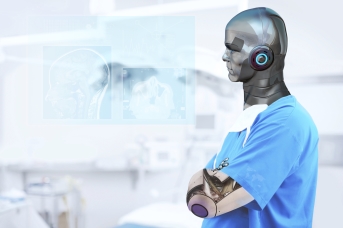Steady stream of innovation to attract funding from diverse industries and drive growth opportunities, finds Frost & Sullivan’s TechVision team
London – 31 May, 2017 – Robotic exoskeletons are rapidly breaking out of the realm of sci-fi, finding application across varied industries, including healthcare, military, sports, robotics, construction, logistics, warehouse and industrial automation. Their exceptional ability to rehabilitate patients with physical or neurological disorders, or enhance the wearer’s physical strength, efficiency, performance capability and functionality, is encouraging research institutes and technology developers to constantly innovate solutions and techniques. Exoskeletons can also be integrated with artificial intelligence, predictive analytics, virtual reality and haptics to deliver a truly futuristic solution.
“In addition to medical benefits, robotic exoskeletons augment the wearer’s physical strength and allow them to lift very heavy weights without using machinery,” noted Frost & Sullivan TechVision Research Analyst S. Kasthuri Jagadeesan. “Currently, the industrial automation industry employs back support suits, power gloves and tool holding exoskeletons to improve worker efficiency, as well as reduce fatigue and stress.”
Emerging Robotic Exoskeleton Technologies is part of Frost & Sullivan’s TechVision (Advanced Manufacturing Automation) Growth Partnership Service programme. The study analyzes the present degree of applicability of robotic exoskeletons and the recent innovations that will have a tremendous impact across industries. It presents a technology road map and determines the impact, growth, adoption rate and role of robotic exoskeletons between 2017 and 2022. By 2022, the wide-scale adoption of robotic exoskeleton technologies is anticipated to increase significantly.
Click here for complimentary access to more information on this analysis and to register for a Growth Strategy Dialogue, a free interactive briefing with Frost & Sullivan’s thought leaders.
Robotic exoskeletons have found substantial application in safety and security industries as well, as they can be used by first responders during dangerous evacuation and rescue situations. Due to these advantages, the military and healthcare industries are investing heavily in the research and development (R&D) of this technology.
Despite the interest shown by a few stakeholders, funding is often tight, partly due to the high R&D costs, while the high cost of implementation is proving a deterrent to mainstream adoption. Once the robotic exoskeleton technology stabilizes and more innovative, segmented solutions are introduced, there will be greater industry and academic participation in technology development and adoption.
“Segmented robotic exoskeletons efficiently perform and address the evolving needs of varied industries, as each segment is designed for particular tasks in particular market segments,” noted Jagadeesan. “In the future, there will be new business opportunities for companies to provide service, software support, and even maintenance/service of exoskeleton suits.”
About TechVision
Frost & Sullivan's global TechVision practice is focused on innovation, disruption and convergence, and provides a variety of technology-based alerts, newsletters and research services as well as growth consulting services. Its premier offering, the TechVision program, identifies and evaluates the most valuable emerging and disruptive technologies enabling products with near-term potential. A unique feature of the TechVision program is an annual selection of 50 technologies that can generate convergence scenarios, possibly disrupt the innovation landscape, and drive transformational growth. View a summary of our TechVision program by clicking on the following link: http://ifrost.frost.com/TechVision_Demo.
About Frost & Sullivan
Frost & Sullivan, the Growth Partnership Company, works in collaboration with clients to leverage visionary innovation that addresses the global challenges and related growth opportunities that will make or break today's market participants. For more than 50 years, we have been developing growth strategies for the global 1000, emerging businesses, the public sector and the investment community. Contact us: Start the discussion
Emerging Robotic Exoskeleton Technologies

